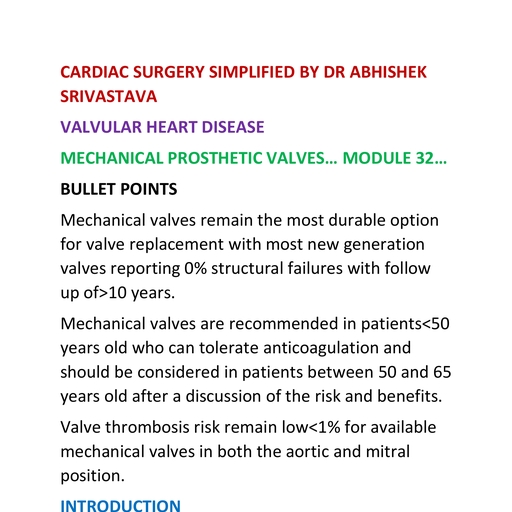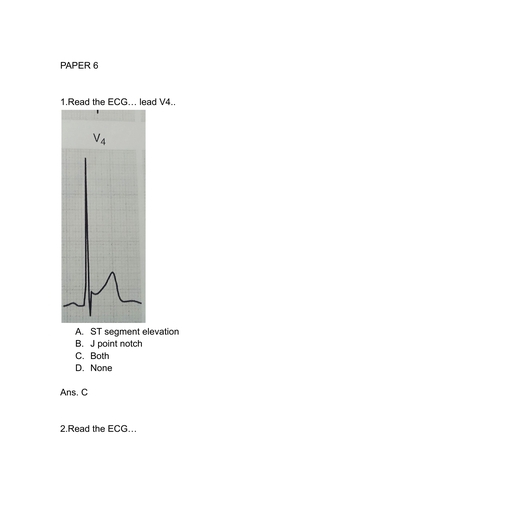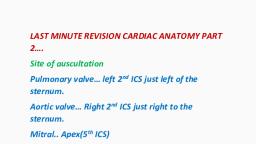Page 1 :
CARDIAC SURGERY SIMPLIFIED BY DR ABHISHEK, SRIVASTAVA, VALVULAR HEART DISEASE, MECHANICAL PROSTHETIC VALVES… MODULE 32…, BULLET POINTS, Mechanical valves remain the most durable option, for valve replacement with most new generation, valves reporting 0% structural failures with follow, up of>10 years., Mechanical valves are recommended in patients<50, years old who can tolerate anticoagulation and, should be considered in patients between 50 and 65, years old after a discussion of the risk and benefits., Valve thrombosis risk remain low<1% for available, mechanical valves in both the aortic and mitral, position., INTRODUCTION, The first mechanical valve implant was performed in, 1950s in which mechanical ball and cage valve
Page 2 :
called the Hufnagel valve was placed in descending, aorta., Harken soroff valve which was first to be placed in, the descending aorta., The first FDA approved valve was the ball and cage, Starr Edwards valve placed in a subcoronary, position., Second generation mechanical valves like the Bjork, shiley tilting disc valve were produced in late 1960s., In an effort to reduce anticoagulation related, complications, bioprosthetic valves and the Ross, procedure were developed as an alternative to, mechanical valve., Finally in 1977 the St. Jude medical valve was first, bileaflet prosthesis was developed., Bileaflet valves allow for increased effective orifice, area, improved hemodynamic and lower profile, allowing for easier implantation.
Page 3 :
With mechanical valve, the main shortcoming is the, risk of thromboembolism, necessitating life long, anticoagulation., , Evolution of mechanical prosthesis…, CURRENT INDICATIONS AND PATIENTS SELECTION, For younger patients who do not have a, Contraindications to therapeutic anticoagulation, and are willing to have lifelong anticoagulation,, mechanical valves are recommended because of
Page 4 :
their durability and lower likelihood of, degeneration requiring reoperation., Older patients who have a lower life expectancy, and higher risk of anticoagulation complications, are ideal candidates for bioprosthetic valve, replacement.
Page 5 :
Factors used for shared decision making about, choice of valve prosthesis...
Page 6 :
MECHANICAL PROSTHESIS GUIDELINE, , European guideline states that mechanical valve, should be considered in patients <60 years old for, the aortic position and <65 years old for the mitral, position., CURRENT MECHANICAL VALVE, Most available valves on the market for both the, aortic and mitral position are bileaflet valves
Page 7 :
composed of pyrolytic carbon disk mounted on a, sewing ring., St. Jude medical...., One of the first bileaflet mechanical valve on the, market was the St. Jude medical,masters series., First implanted in 1977., The masters series is the most widely implanted, prosthetic valve in the world., The most recent modifications called the regent, valve has modified external design that allows for, larger orifice area without changing the pivot, mechanism of valve., Regent is seated in supra annular position., Ideal valve for a small annulus., Regent valve is only indicated for the aortic, position., CRYO LIFE...., The ON-X mechanical valve was first implanted in, 1996.
Page 8 :
In 2016 it was acquired by cryo life., The ON-X valve has an excellent hemodynamic, profile and long term durability., LIVA NOVA, First introduced in 1986,the carbomedics, mechanical valve merged with LIVA nova in 2015., MEDTRONIC, The medtronic line of mechanical valve consists of, open pivot., First implanted in 1992., CONCLUSION, The available bileaflet mechanical valve offer, excellent hemodynamics with low rate of, thromboembolic events and remains most durable, options for valve replacement.



































































